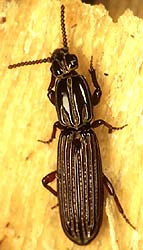
Clinidium is a genus of wrinkled bark beetles in the subfamily Rhysodinae. Most species are Neotropical, but some occur further north in North America and there is also one species in Europe and one in Japan. Two species are known from Miocene amber.
Clinidium bechyneorum is a species of ground beetle in the subfamily Rhysodinae. It was described by R.T. Bell & J.R. Bell in 1985. It is known from its type locality in Carabobo, northern Venezuela. An additional specimen that might represent a distinct species is from the neighboring Aragua state. The species is named for J. Bechyne and B. Bechyne, collectors of the type series and many other Clinidium specimens.
Clinidium excavatum is a species of ground beetle in the subfamily Rhysodinae. It was described by R.T. Bell & J.R. Bell in 1985. It is known from its type locality in Carabobo, northern Venezuela. Clinidium excavatum measure 6.5–6.8 mm (0.26–0.27 in) in length.
Clinidium smithsonianum is a species of ground beetle in the subfamily Rhysodinae. It was described by R.T. Bell & J.R. Bell in 1985. Clinidium smithsonianum is known from Dominica. It measures 5–6.1 mm (0.20–0.24 in) in length.
Clinidium apertum is a species of ground beetle in the subfamily Rhysodinae. It was described by Edmund Reitter in 1880. It is endemic to the eastern United States.
Clinidium blomi is a species of ground beetle in the subfamily Rhysodinae. It was described by R.T. Bell in 1970. It is endemic to the High Plateau of Chiapas in southeastern Mexico.
Clinidium boroquense is a species of ground beetle in the subfamily Rhysodinae. It was described by R.T. Bell in 1970. It is endemic to Puerto Rico.
Clinidium chiolinoi is a species of ground beetle in the subfamily Rhysodinae. It was described by R.T. Bell in 1970. It is endemic to Jamaica. Clinidium chiolinoi measure 4.4–5.6 mm (0.17–0.22 in) in length.
Clinidium corbis is a species of ground beetle in the subfamily Rhysodinae. It was described by R.T. Bell in 1970. It is endemic to Hispaniola. Clinidium corbis measure 4.4–5.5 mm (0.17–0.22 in) in length.
Clinidium darlingtoni is a species of ground beetle in the subfamily Rhysodinae. It was described by R.T. Bell in 1970. It is endemic to Jamaica.
Clinidium haitiense is a species of ground beetle in the subfamily Rhysodinae. It was described by R.T.Bell in 1970. It is known from La Selle Range in Haiti. Clinidium haitiense measure 5.7–6.4 mm (0.22–0.25 in) in length.
Clinidium incis is a species of ground beetle in the subfamily Rhysodinae. It was described by R.T. Bell in 1970. It is endemic to Puerto Rico. The specific name is derived from the Latin incus and refers to the type locality, El Yunque, which is the Spanish word for anvil. Grammatically, the spelling should have been incudis.
Clinidium rossi is a species of ground beetle in the subfamily Rhysodinae. It was described by Ross Bell in 1970. It is known from Golfito in Costa Rica. The holotype, a male, measures 4.1 mm (0.16 in) in length.
Clinidium sulcigaster is a species of ground beetle in the subfamily Rhysodinae. It was described by Ross T. Bell in 1970. It is known from near Lake Atitlán in Guatemala. The holotype is a male measuring 5.5 mm (0.22 in) in length.
Clinidium valentinei is a species of ground beetle in the subfamily Rhysodinae. It was described by R.T. Bell in 1970. It is endemic to the Appalachian Mountains in the eastern United States, from northern Alabama to southwestern Pennsylvania.
Clinidium xenopodium is a species of ground beetle in the subfamily Rhysodinae. It was described by R.T. Bell in 1970. It is endemic to the Dominican Republic (Hispaniola).

Clinidium baldufi is a species of ground beetle in the subfamily Rhysodinae. It was described by R.T. Bell in 1970. It is endemic to the central and eastern United States, east of central Iowa, southeastern Missouri and southwestern Mississippi, as far south as northern Florida, and north to northern Illinois, Pennsylvania, and New Jersey.
Clinidium rojasi is a species of ground beetle in the subfamily Rhysodinae. It was described by Louis Alexandre Auguste Chevrolat in 1873. It is known from the mountains of northern Venezuela between Falcón and Aragua states and from Guyana.
Clinidium sculptile is a species of ground beetle in the subfamily Rhysodinae. It was described by Edward Newman in 1838. It is endemic to the eastern United States, primarily Appalachia. It has been recorded on pitch pine and tulip tree.

Ross Taylor Bell was an American entomologist with particular interest in the invertebrate natural history of Vermont, United States, and carabid beetles. Together with his wife, Joyce Bell, his work at the University of Vermont was largely taxonomic, where they described more than 75% of the rhysodine species known to science. Ross also wrote a number of seminal papers in his chosen field.


